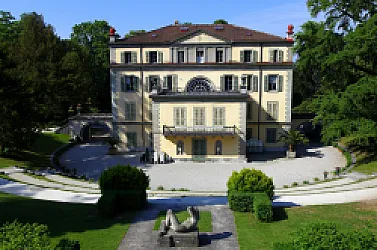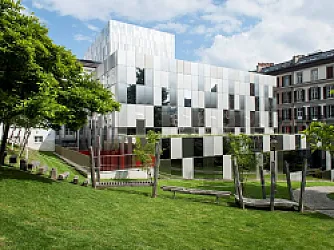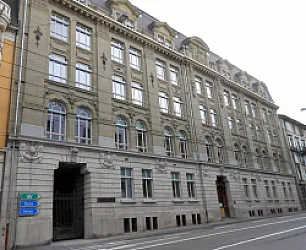Visit Lausanne in 2 days
8 must-see POIs, optimized routes and anecdotes.
Loading map...
You will visit the most beautiful points of interest in Lausanne
2 Days in Lausanne — A Lakeside Love Story
Lausanne stole my heart the moment I stepped off the train. The city feels like a song sung by the lake. Known as the "Olympic Capital," Lausanne mixes athletic energy with old-world charm. Some say it's overrated, but I found it quietly perfect. I remember wandering narrow streets after rain, the air smelling of coffee and wet stone. This was my first real Swiss surprise.
Why visit Lausanne? Because it is more than a postcard. The city hums with university life, café chatter, and unexpected gardens. You’ll stroll through Mon-Repos Park and feel time slow under chestnut trees. Place de la Louve offers a slice of local life and handsome facades. Walk the Promenade Jean-Villard-Gilles to taste the lake breeze and watch sailboats glide. You see elegant architecture, hear church bells, and taste pastries that deserve their spotlight. This is the kind of place that leaves you smiling for days.
Planning a trip can feel overwhelming. Lausanne is compact, yet full of surprises; you could easily spend weeks exploring. If this is your first time in Lausanne, I understand the anxiety of wanting to see it all. That’s exactly why I created this Lausanne itinerary. Below I’ll show you how to spend 2 days in Lausanne without rushing. You’ll hit the highlights—Mon-Repos Park, Place de la Louve, Promenade Jean-Villard-Gilles, and even the University Polyclinic—while keeping a relaxed pace.
Key tip: expect hills and bring comfortable shoes. Lausanne’s charm comes with steep streets and rewarding viewpoints. Walking slowly lets you absorb details, stop for coffee, and catch the soft light over the lake. This makes a huge difference for enjoying what to see in Lausanne. Pace matters more than a packed checklist. Now let’s dive into the itinerary and make these two days feel like a small, perfect holiday.

Quick Mini Guide to Lausanne
Where to stay:
- Ouchy — lakeside hotels, best for morning promenades on Promenade Jean‑Villard‑Gilles and boat links.
- Flon — central, historic-to-modern hub for restaurants and quick access to shops and nightlife.
- Gare (train station) — practical if arriving by train; fast connections via M2 metro to hilltop attractions.
When to visit:
- Late spring–early autumn for warm lakeside walks and vineyard views (Lavaux nearby).
- Weekdays for quieter museums and parks; weekends get busy by the lake and at Ouchy.
Things to do:
- Walk Promenade Jean‑Villard‑Gilles along Lake Geneva at sunrise or sunset — short, flat, scenic.
- Relax in Mon‑Repos Park — peaceful Victorian gardens ideal for a picnic near the university sector.
- Stroll Place de la Louve — café terraces and local patisseries; good for people‑watching.
- Visit University Polyclinic area — notable modern medical campus (appointments only for consultations).
- Book interactive tours: The Alchemist LAUSANNE and The Trophy of the Tribes LAUSANNE — immersive, 60–90 min experiences; reserve ahead.
Don't forget:
- Comfortable shoes — Lausanne is steep; use the M2 metro to save energy.
- Check boat timetables on Lake Geneva and buy Mobilis ticket for local transport zones.
- Carry a light layer for lakeside breezes and bring a rechargeable card (contactless widely accepted).
Day 1 - Lausanne
4 POIs to discoverDay 1 - Morning à Lausanne
4 Points of interest - Duration : 3h00 - Distance : 2.1 km - Walking : 0h27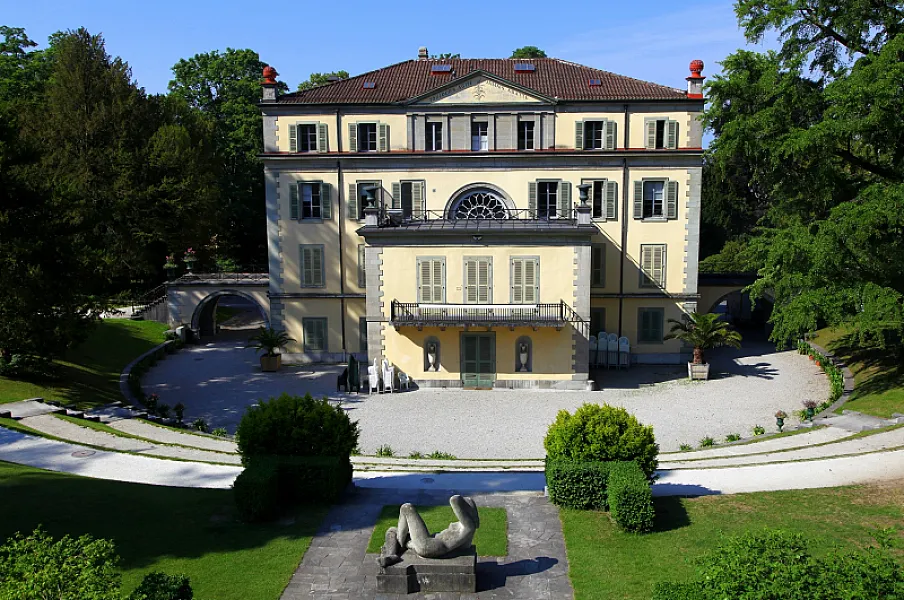
Mon-Repos Park
- Parc de Mon-Repos is an English-style garden, developed in the 18th century.
- The estate includes a master villa, octagonal kiosk, theater, stables, farmhouse, orangery and neo-Gothic tower.
- The park is home to a botanical collection featuring hundreds of rare species.
- It boasts several remarkable trees, including a giant sequoia and a fern-leaved beech. There is an indoor swimming pool on the west side of the park.

Place de la Louve
- Place de la Louve takes its name from the river of the same name, now arched.
- Originally, a path led down from the Cité hill, over the bridge over the Louve, then up towards Saint-Laurent.
- In the 18th century, a staircase was built to access the terrace.
- The front of the town hall can be accessed via a small covered passageway.
- The square is embellished with four fountains and swings illuminated during the Lausanne Lumières festival.
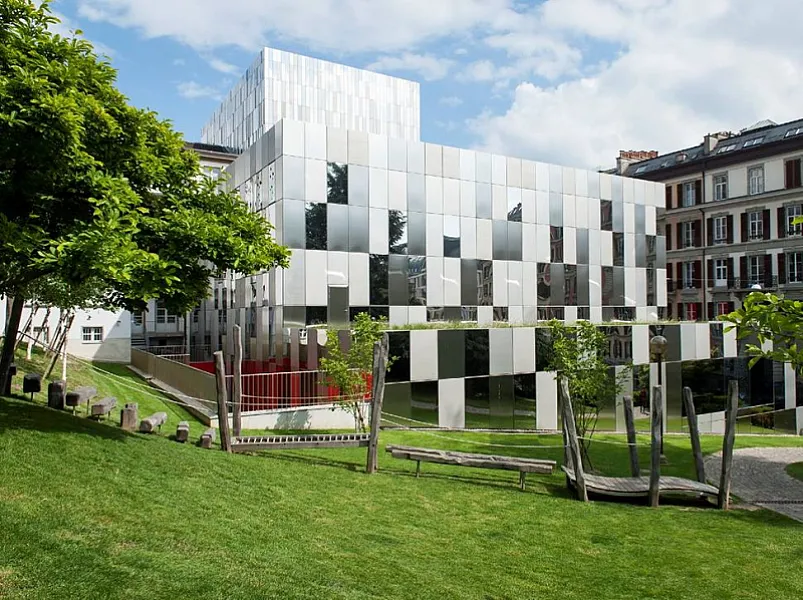
Promenade Jean-Villard-Gilles
- Lausanne's new Opéra inspired the creation of a balancing trail between the avenues du Théâtre and de Beau-Séjour.
- The trail invites children to explore balancing elements made of wood and ropes.
- The trail blends discreetly into the promenade, with the mirrored façade of the Opera House in the background.
- A garden-theater features the "Grande Pimprenelle" project, a poetic story inspired by the lives of the plants that find their place there.
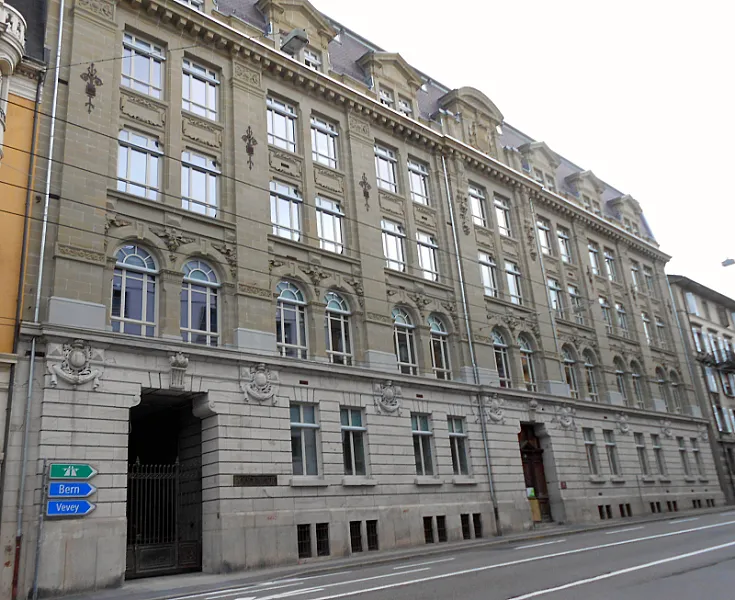
University Polyclinic
- � The Policlinique médicale universitaire (PMU) is a reference center in internal medicine, general and community health.
- It offers care to the population in consultation, emergency and Flon Permanence without appointment.
- Multidisciplinary research teams work on evolving clinical knowledge, especially in internal medicine, preventive and community health.
- The PMU provides high-quality specialized care in diverse areas such as cardiology, gastroenterology, liaison psychiatry, among others.
- It offers services in alcoology, diabetology, vaccination, and more, as well as care in specific areas such as obesity, osteoporosis, and tabacology.
Day 2 - Lausanne
4 POIs to discoverDay 2 - Morning à Lausanne
4 Points of interest - Duration : 3h00 - Distance : 2.1 km - Walking : 0h27
Mon-Repos Park
- Parc de Mon-Repos is an English-style garden, developed in the 18th century.
- The estate includes a master villa, octagonal kiosk, theater, stables, farmhouse, orangery and neo-Gothic tower.
- The park is home to a botanical collection featuring hundreds of rare species.
- It boasts several remarkable trees, including a giant sequoia and a fern-leaved beech. There is an indoor swimming pool on the west side of the park.

Place de la Louve
- Place de la Louve takes its name from the river of the same name, now arched.
- Originally, a path led down from the Cité hill, over the bridge over the Louve, then up towards Saint-Laurent.
- In the 18th century, a staircase was built to access the terrace.
- The front of the town hall can be accessed via a small covered passageway.
- The square is embellished with four fountains and swings illuminated during the Lausanne Lumières festival.

Promenade Jean-Villard-Gilles
- Lausanne's new Opéra inspired the creation of a balancing trail between the avenues du Théâtre and de Beau-Séjour.
- The trail invites children to explore balancing elements made of wood and ropes.
- The trail blends discreetly into the promenade, with the mirrored façade of the Opera House in the background.
- A garden-theater features the "Grande Pimprenelle" project, a poetic story inspired by the lives of the plants that find their place there.

University Polyclinic
- � The Policlinique médicale universitaire (PMU) is a reference center in internal medicine, general and community health.
- It offers care to the population in consultation, emergency and Flon Permanence without appointment.
- Multidisciplinary research teams work on evolving clinical knowledge, especially in internal medicine, preventive and community health.
- The PMU provides high-quality specialized care in diverse areas such as cardiology, gastroenterology, liaison psychiatry, among others.
- It offers services in alcoology, diabetology, vaccination, and more, as well as care in specific areas such as obesity, osteoporosis, and tabacology.
Where to Stay in Lausanne
Picking the right place to stay in Lausanne makes a short two-day visit feel calmly efficient rather than rushed. Because the city is compact but famously hilly, your base determines how much of your time is spent enjoying sights like the lakeside promenade or queuing for transport. Choose a location that matches your priorities—easy lake access and relaxed views, or proximity to museums, cafés and evening life—and you’ll get far more out of a brief trip.
Lausanne is organised around the lakefront, a lively central spine and the higher residential plateaus. Movement is typically vertical as well as horizontal: expect steps and slopes, but also a very reliable public network that shortens those climbs. The metro line M2 runs between the lake at Ouchy and the city centre, while buses fill in across neighbourhoods; the main train station (Lausanne Gare) is a convenient rail hub for arrivals and day trips. This layout makes it easy to be based slightly off the beaten path without losing time.
For a lakeside stay, consider the area around Ouchy and the Promenade Jean-Villard-Gilles, where mornings on the water and sunset strolls are the reward for choosing calm, scenic lodging. If you want to be in the thick of cafés, shopping and lively squares, aim for the City Centre / Flon near Place de la Louve—you’ll be a short walk from museums and nightlife. For visits connected to medicine or university business, staying near the University Polyclinic (CHUV) saves travel time and offers quieter, residential streets with good tram and bus links.
Transport-wise, opt for accommodation close to an M2 station or a major bus stop if you want to minimise walking uphill; the ticket system is straightforward and many small hotels will point you to the nearest tourist transport pass. Taxis are available but often unnecessary for a two-day stay unless mobility is an issue—packing comfortable shoes is the simplest hack.
Finally, trust your priorities: pick lakefront for relaxation, central/Flon for convenience, or CHUV-area for practicality. Book a room on a quieter side street if you’re sensitive to noise, and remember that a short walk or one metro ride can connect you to Lausanne’s highlights so you can keep your stay focused and pleasantly relaxed.
Getting Around Lausanne
Lausanne is delightfully compact and its public transport feels made for visitors — quick, frequent and easy to read. The network is run by TL and includes buses and two metro lines, most famously the steep automated Metro M2 that zips from the lakeside at Ouchy up to the hills in minutes 🚇. Stops are well signed, announcements are clear, and many routes converge at central hubs like Flon, so even if you only speak a little French you’ll find your way without drama.
A practical tip: always buy your ticket before you get on. You can use the yellow machines at stops, the TL app or the SBB Mobile app, and tickets are typically valid for 60 minutes across the relevant zones. Lausanne sits largely in Mobilis zone 11 for central travel; single fares in the city are around CHF 3–3.50 (prices can change, so check the app). Also ask your hotel about the Lausanne Transport Card — many places give it to guests for free and it covers your local rides during your stay, which is a lovely money-saver 🎫.
Google Maps and the TL app are your best friends for real-time routing. I always check Google for walking-plus-transit combinations when I’m short on time and use the TL app to buy tickets and see live departure times. If you plan several trips in a day, compare a day pass versus single tickets — sometimes a Mobilis day pass that covers neighbouring zones ends up cheaper if you’re hopping around the city and to nearby towns.
For saving money, aim to walk when the weather’s nice — many sights are close together — and combine that with strategic transit runs. Using the hotel’s transport card, buying a 24-hour Mobilis pass on busy days, or simply timing your journeys to avoid peak tourist shuttles can keep costs down. Inspectors do check tickets, so digital proof or a printed ticket is important; fines are unpleasantly punctual in Switzerland.
On a personal note: once we wanted to go from Place de la Louve down to the Promenade Jean-Villard-Gilles and then across to Mon-Repos Park. We walked from Place de la Louve to Flon, hopped on the M2 for two stops to Ouchy-Olympique, and then strolled the lakeside promenade — the metro ride was under 10 minutes and suddenly we were watching sailboats. From there Mon-Repos was a relaxed 15-minute walk along the water; easy, scenic and the sort of simple pleasure that makes Lausanne’s transport feel like part of the adventure 🗺️.
What to Pack for Lausanne
Lausanne is a compact, very walkable city—but it's hilly, cobbled and full of architectural corners that make you stop every two minutes. I’ve done day trips where I walked 12 km (about 7.5 miles) and was out for 10+ hours, so I pack for comfort, weather swings and keeping my devices alive while I roam between the cathedral, lakeside and unexpected modern buildings.
1. Comfortable walking shoes (REQUIRED): Shoes matter here. Think a sturdy sneaker with good sole—my go-to is Ecco Soft 7 because it grips cobblestones and doesn’t kill my feet after long uphill stretches. WHY: Lausanne has steep streets (Ouchy up to the cathedral is a workout) and uneven pavement; I once walked 15,000 steps in one day and a flimsy shoe ruined the afternoon. Cushion + traction = more time enjoying façades, not nursing blisters.
2. Cross-body bag: I always use a zipped cross-body with RFID pocket—small but organised. WHY: You’ll be in crowded places around landmark sites and public transit; having passports, a card and a map close to your body keeps everything accessible and secure. I once had to fend off a pickpocket attempt in a busy square in another Swiss city—hands-free and zipped would-be saved me time and stress.
3. Weather-appropriate clothing for Lausanne: Pack layers: a light merino tee, thin sweater and a packable shell. WHY: Weather can flip—sunny by Lake Geneva in the morning, chilly and windy near the cathedral later. On a spring trip I started in a T-shirt at 18°C and needed a windbreaker by sunset; layers kept me comfortable without lugging a heavy coat.
4. Power adapter (Swiss Type J / compatible Type C) and voltage note: Bring an adapter for Swiss outlets (Type J; many plugs accept Type C too) and remember Switzerland uses 230V. WHY: If you’re charging a camera or travel hair tools, adapters are essential. I learned this the hard way when my camera battery died mid-sunset shoot and the hotel only had Swiss sockets.
5. Power bank (10,000–20,000 mAh): A mid-size 10,000 mAh bank will usually refill a phone 2–3 times; 20,000 mAh if you’re heavy on photos. WHY: You’ll be taking pics of facades and searching maps between landmarks—my phone hit 6% after a long photo-heavy afternoon once, and a 10,000 mAh bank kept me powered through dinner and train home.
6. Optional but recommended: packable rain jacket and a small umbrella: Lightweight waterproof layer and tiny umbrella fit in your bag without bulk. WHY: Lausanne’s lakeside weather can surprise you with short showers—on a chilly afternoon I stayed dry and kept exploring because my jacket folded into a tiny pouch.
Enjoy Your Trip to Lausanne!
Voilà — a lively 2-day plan packed with discoveries: four handpicked spots that give you a real taste of Lausanne. From the leafy calm of Mon-Repos Park to the historic charm of Place de la Louve and the striking University Polyclinic, this itinerary has everything you need to see key landmarks, admire architecture, and soak up local atmosphere.
Remember: this is a GUIDE, not a strict schedule. Be gentle with your plans and leave room for the unexpected. The best moments often come from wandering narrow streets, getting pleasantly lost, or slipping into a spontaneous café. Don’t feel pressured to see EVERYTHING — a relaxed pace lets the city surprise you and makes room for serendipity.
I’m excited for you — you’re going to love Lausanne’s mix of history, design, and green spaces. Take photos, taste local treats, chat with locals, and collect unforgettable memories. Trust your curiosity and let small detours become the highlights of your trip.
Want to explore in a playful way? Check out Coddy’s interactive tours for a gamified city hunt: The Alchemist LAUSANNE and The Trophy of the Tribes LAUSANNE turn sightseeing into a little adventure and are perfect for adding fun to your two days.
Enjoy every minute of your Lausanne escape — and if you want tips or want to share a story when you return, I’d love to hear it. Safe travels! Have fun! Enjoy!
Want more adventure?
Discover our urban escape games to transform your visit into an interactive adventure!










